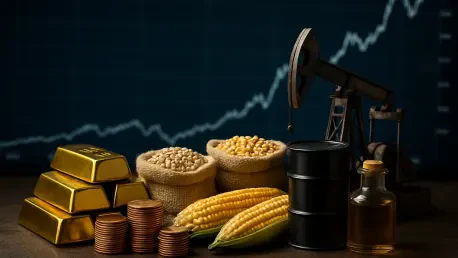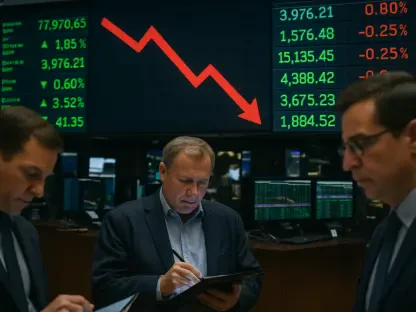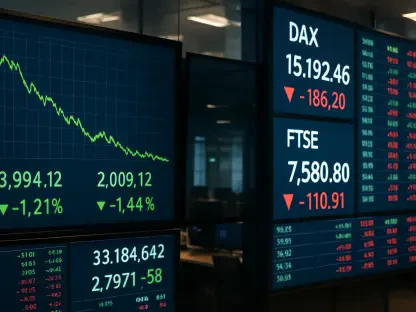In the dynamic financial landscape of 2025, a historic surge in commodity prices, particularly in precious metals like gold and silver, is fundamentally altering the way investors construct their portfolios, reflecting deeper economic undercurrents and geopolitical tensions that are impossible to ignore. Gold has shattered records by exceeding $4,300 per ounce, while silver has seen an astonishing 75% increase year-to-date, marking this as an unprecedented “gold rush” that goes far beyond mere speculation. This phenomenon is not just about price spikes but signals persistent inflation, political instability, and shifting central bank policies, where traditional asset classes are increasingly volatile. Commodities, long viewed as risky or secondary investments, are now emerging as indispensable tools for diversification and risk mitigation. This dramatic shift compels a reevaluation of long-held investment principles, as tangible assets take center stage in safeguarding wealth. The implications of this surge ripple across industries, economies, and global financial systems, demanding a closer look at what drives this boom and how it reshapes strategic thinking. This article delves into the forces propelling commodity prices, their critical role in modern portfolios, the uneven impacts on various sectors, and the broader transformations they signal for the global economy.
Unpacking the Forces Fueling the Boom
The remarkable rise in commodity prices in 2025 is not a random occurrence but a direct response to a confluence of powerful global forces that have reshaped market dynamics. Geopolitical unrest, characterized by ongoing conflicts and political uncertainties across multiple regions, has created an environment of pervasive risk, driving investors toward safe-haven assets like gold and silver. These precious metals are seen as reliable stores of value when trust in governmental stability wanes. Central banks, particularly in emerging economies such as China, are playing a significant role by aggressively accumulating gold to diversify their reserves and reduce dependence on the U.S. dollar. This strategic move, often termed de-dollarization, underscores a broader distrust in traditional currency systems amid global tensions. Inflation, which remains stubbornly high despite monetary tightening, further amplifies the appeal of commodities. Unlike paper money, which loses value as prices rise, tangible assets provide a hedge against the erosion of purchasing power. These combined factors create a solid foundation for the current rally, distinguishing it from past speculative frenzies that often collapsed under their own weight.
Beyond the immediate triggers, the commodity surge is also underpinned by structural shifts in global economic behavior that suggest long-term sustainability for elevated prices. The persistent central bank demand for gold is not merely a reaction to current events but part of a calculated effort to reconfigure national reserves in anticipation of future uncertainties. This trend is complemented by retail and institutional investors alike flocking to precious metals as a counterbalance to volatile equity markets. Moreover, inflationary pressures are not expected to dissipate quickly, given supply chain disruptions and energy cost fluctuations that continue to drive up consumer prices. The result is a market environment where commodities are not just a temporary refuge but a fundamental component of financial planning. This shift in perception is critical, as it moves commodities from the fringes of investment strategy to a central pillar, reflecting a broader acknowledgment of their role in stabilizing returns during turbulent times. The durability of these drivers indicates that the current boom may have staying power, even if short-term corrections occur.
Repositioning Commodities in Investment Frameworks
As economic turbulence defines 2025, commodities are being repositioned as essential elements of diversified investment portfolios, offering unique advantages over traditional assets. Their low correlation with stocks and bonds makes them a powerful tool for reducing overall portfolio risk. When equity markets falter or fixed-income assets underperform due to rising interest rates, commodities often move independently, providing a stabilizing effect. This characteristic is particularly valuable in the current climate, where global uncertainties can trigger sudden market downturns. For investors, incorporating commodities means creating a buffer that can absorb shocks from other asset classes, ensuring that a single adverse event does not derail long-term financial goals. This strategic pivot reflects a growing recognition that reliance on conventional investments alone may no longer suffice in an era of heightened volatility.
Equally important is the role of commodities as a defense against inflation, which continues to challenge economies worldwide. With prices for goods and services climbing, the real value of cash holdings and fixed-income returns diminishes, leaving investors vulnerable to wealth erosion. Commodities like gold and silver, however, tend to retain or even increase their value during such periods, acting as a reliable store of wealth. This protective quality is not just theoretical but evidenced by the current market, where precious metal prices have soared in response to persistent price pressures. Additionally, commodities contribute to risk management by offering stability during geopolitical crises that can destabilize other investments. Their tangible nature provides a sense of security that intangible assets cannot match, making them a cornerstone of modern portfolio construction. This evolution in thinking marks a departure from past approaches, positioning commodities as central to achieving resilience in unpredictable times.
Economic Ripples: Beneficiaries and Challenges
The commodity price surge is creating a divided economic landscape, with distinct winners emerging alongside sectors grappling with significant hurdles. Gold and silver mining companies, such as Barrick Gold Corporation and Pan American Silver Corp., are experiencing substantial gains as elevated prices translate into higher revenues and improved profitability. These firms are not only benefiting from increased cash flows but also gaining the flexibility to reduce debt, enhance shareholder returns, or expand exploration efforts. Beyond the miners themselves, ancillary industries are also profiting from the boom. Equipment manufacturers like Caterpillar Inc. are seeing heightened demand for machinery and tools as mining operations scale up to capitalize on favorable market conditions. This cascading effect illustrates how a rally in commodity prices can invigorate entire supply chains, creating opportunities for growth in related sectors that support resource extraction.
On the flip side, industries reliant on commodities as raw materials are facing mounting pressures that threaten their financial health. Manufacturing giants and aerospace leaders, including General Motors and Boeing, are contending with soaring costs for essential inputs like copper and aluminum, which are integral to their production processes. These rising expenses squeeze profit margins, especially in competitive markets where passing costs onto consumers is not always feasible. Without effective hedging strategies or alternative sourcing options, such companies risk diminished earnings and reduced market share. This stark contrast between beneficiaries and those burdened by the commodity boom highlights the uneven impact across the economic spectrum. It also emphasizes the necessity for corporate agility, as businesses must adapt through innovation or risk management to navigate the challenges posed by a high-cost environment driven by commodity price spikes.
Global Implications and Systemic Transformations
The commodity boom extends far beyond individual markets, intertwining with profound shifts in the global financial architecture that could redefine economic relationships. A notable trend is the acceleration of de-dollarization, as central banks around the world bolster their gold holdings to mitigate geopolitical and monetary risks associated with over-reliance on the U.S. dollar. This strategic pivot signals a potential reconfiguration of reserve assets, challenging the long-standing dominance of the dollar in international trade and finance. Such a shift could influence everything from foreign exchange rates to bond yields, altering the cost of borrowing for nations and corporations alike. The implications are far-reaching, suggesting that the current commodity surge is not merely a market anomaly but a symptom of deeper changes in how global wealth is stored and managed.
Furthermore, the volatility accompanying rising commodity prices is likely to draw increased regulatory attention, as policymakers grapple with ensuring market stability and transparency. Governments may consider measures such as enhanced oversight of trading practices or the establishment of strategic reserves for critical materials to prevent supply shocks. At the same time, the environmental footprint of intensified mining activities raises pressing concerns, fueling discussions on sustainable resource extraction. Balancing economic benefits with ecological responsibility becomes a critical challenge, as the push for commodities to support industrial and green energy needs clashes with the imperative to minimize environmental harm. These systemic issues underscore that the commodity surge is a catalyst for broader policy debates, shaping not just financial strategies but also the intersection of economics, governance, and sustainability in 2025.
Navigating the Future of Commodity Investments
Reflecting on the extraordinary commodity surge that defined markets in recent times, it becomes evident that this period marked a turning point for investment approaches. The unprecedented rise in gold and silver prices, driven by geopolitical unrest, inflation, and central bank strategies, reshaped how tangible assets were integrated into financial planning. Industries felt the impact unevenly, with mining sectors thriving while others struggled under cost burdens, revealing the complex ripple effects across economies. Broader trends, such as the move away from dollar dominance and heightened regulatory focus, signaled that these price movements were part of a larger structural evolution in global finance.
Looking ahead, investors would be wise to closely monitor key indicators such as central bank policies, inflation trends, and geopolitical developments to anticipate shifts in commodity markets. Diversifying exposure within this asset class—balancing precious metals with industrial resources like lithium and copper, crucial for green energy transitions—could mitigate risks associated with volatility. Staying informed about regulatory changes and sustainability mandates will also be essential, as these factors could influence market dynamics and operational costs. The lessons from this historic rally emphasize adaptability, urging a proactive stance in leveraging commodities not just as hedges but as integral components of a forward-thinking portfolio strategy.









